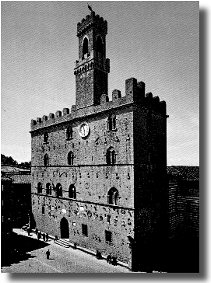With the name of Velathri, centre of Villanovian civilisation (between the IX and VII centuries B.C.), Volterra was one of the Etruscan city-states. In the III century B.C., it joined the Dodecapolis, the religious, cultural and commercial Italic Federation formed by of the largest Etruscan cities, though continuing to maintain its own trade regulations and taking part in the thriving commercial activity of northern Etruria.
With Populonia and Charmas, perhaps today's Chiusi (as it seems from an ancient coin minted for the occasion), it stipulated a commercial treaty which contributed to its further development and brought it to great splendour between the V and I centuries B.C.
Like all Etruscan cities, the small city-state was ruled by a Lucumon, political and military head of state, who governed with a council of nobles, while the working classes were tied to the noble families by a relation of clientage. The city was surrounded by walls around which extended the necropoli, veritable cities of the dead.
|
| The Palazzo dei Priori in Volterra |
The necropoli were very well kept, given that in Etruscan belief the spirit and remains of the dead survived after death. Hence the locules were spacious and abounded in funerary ornaments and trappings. Indeed, jewels were found in the necropoli, but also tokens dear to the deceased and objects of his daily life. Today's Pian di Castello was the site of the acropolis, the first nucleus of the city where the greatest temples were built and dedicated to the greater and lesser divinities.
Defeated by Lucius Scipiones Barbatus in 298, the city was forced to enter the federated cities of Rome and contributed to Roman life by sending military aid and provisions during the Second Punic War. The laying of a road along the coast cut Volterra out of the trade routes of the period, relegating it a place among the many little Roman townships.
With the interference of the Church in the V century A.D., it became a bishopric and county centre of the Pannocchieschi family. At times Guelph, at times Ghibelline, Volterra was constantly engaged in wars with San Gimignano, Florence, Pisa and Siena until the Belforti Seigniory in 1340, followed by that of the Florentines in 1361.
In 1472, war broke out for the control of the alum mines and in 1530, the war with Florence; hence came the events tied to the Duchy of Florence, followed by those of the Grand Duchy of Tuscany. Today it is a renowned tourist centre which, in addition to its ancient history, also owes its fame to the alabaster extracted in its nearby quarries.
In antiquity used by the Etruscans and Romans, who made sarcophagi, urns and vases, alabaster fell out of use for centuries until Marcello Inghirami opened a workshop-school in 1791. Today Volterra is one of the most important centres for the artistic production of objects of alabaster.


